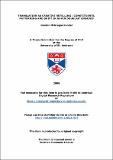Files in this item
Translation as creative retelling : constituents, patterning and shift in Gavin Douglas' Eneados
Item metadata
| dc.contributor.advisor | MacLachlan, Christopher | |
| dc.contributor.author | Kendal, Gordon | |
| dc.coverage.spatial | 252 | en |
| dc.date.accessioned | 2008-11-13T15:14:32Z | |
| dc.date.available | 2008-11-13T15:14:32Z | |
| dc.date.issued | 2008-11-21 | |
| dc.identifier.uri | https://hdl.handle.net/10023/554 | |
| dc.description.abstract | The Thesis analyses and evaluates how Gavin Douglas (Eneados, 1513) has refocused Virgil's Aeneid, principally by giving more emphasis to the serial particularity inherent in the story, loosening the narrative structure and involving the reader in its retelling. Chapter I pieces together (from the evidence not merely of what Douglas explicitly says, but of what his words imply) what for him a "text" in general is, and what accordingly it means for a translator or a reader to be engaged with it. This sets the scene for what follows. The next four Chapters look in turn at how he re-expresses important (metaphysical) characteristics of the story. In Chapter II his handling of time is discussed, and compared with Virgil's: the Chapter sets out in detail how Douglas consistently refocuses temporal predicates, foregrounding their disjunctiveness and making them differently felt. In Chapter III spatial position and distance are analysed, and Douglas' way of dealing with space is found to display parallels with his treatment of time: networks are loosened and nodal points are accentuated. In Chapter IV the way in which he presents individuals is compared with Virgil's, and a similar repatterning and shift reveals itself: Douglas provides his persons with firmer boundaries. Chapter V deals with fate, where Douglas encounters special difficulties but maintains his characteristic way of handling the story. The aim of these four Chapters is to characterise formally how Douglas concretises and vivifies the tale of Aeneas, engaging his readers throughout in the retelling. Finally, Chapter VI looks at certain general principles of translation theory (notably connected with the ideas of faithfulness and accuracy) and argues for a way in which Douglas' translation can be fairly experienced by the reader and fairly evaluated as a lively retelling which (albeit distinctive) is fundamentally faithful to Virgil. | en |
| dc.format.extent | 1160170 bytes | |
| dc.format.mimetype | application/pdf | |
| dc.language.iso | en | en |
| dc.publisher | University of St Andrews | |
| dc.rights | Creative Commons Attribution-NonCommercial-NoDerivs 3.0 Unported | |
| dc.rights.uri | http://creativecommons.org/licenses/by-nc-nd/3.0/ | |
| dc.subject | Aeneid | en |
| dc.subject | Translation | en |
| dc.subject | Renaissance | en |
| dc.subject | Scots | en |
| dc.subject | Narrative | en |
| dc.subject | Hermeneutics | en |
| dc.subject.lcc | PR2253.K4 | |
| dc.subject.lcsh | Douglas, Gavin, 1474?-1522--Eneados--Criticism, Textual | en |
| dc.subject.lcsh | Douglas, Gavin, 1474?-1522--Knowledge--Language and languages | en |
| dc.subject.lcsh | Virgil--Aeneis | en |
| dc.subject.lcsh | Virgil--Translations into Scots--History and criticism | en |
| dc.subject.lcsh | Epic poetry, Latin--Translations into Scots--History and criticism | en |
| dc.subject.lcsh | Translating and interpreting--Scotland--History--16th century | en |
| dc.subject.lcsh | Hermeneutics | en |
| dc.title | Translation as creative retelling : constituents, patterning and shift in Gavin Douglas' Eneados | en |
| dc.type | Thesis | en |
| dc.type.qualificationlevel | Doctoral | en |
| dc.type.qualificationname | PhD Doctor of Philosophy | en |
| dc.publisher.institution | The University of St Andrews | en |
This item appears in the following Collection(s)
Except where otherwise noted within the work, this item's licence for re-use is described as Creative Commons Attribution-NonCommercial-NoDerivs 3.0 Unported
Items in the St Andrews Research Repository are protected by copyright, with all rights reserved, unless otherwise indicated.


